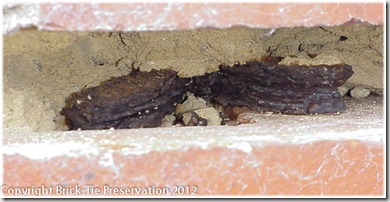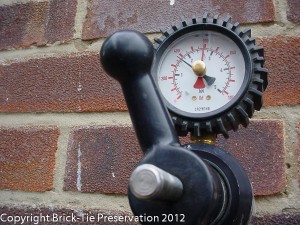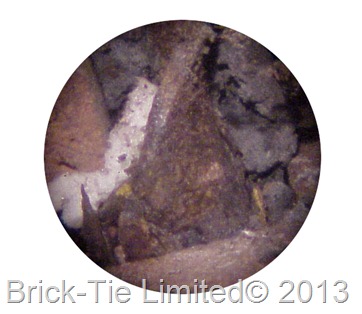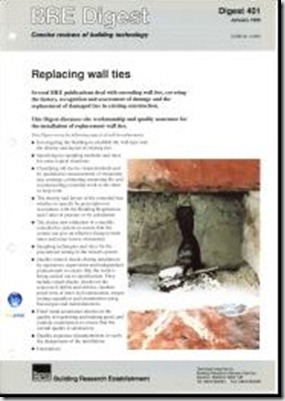Sound like a daft question? Not really; the problem with corroding cavity wall ties is that there are many types and thicknesses of wall tie and as site inspections are done visually; subjectivity comes into play. One man’s corroded wall tie may be described as ‘pristine’ by another onlooker.
Disagreements on ‘How rusty is rusty’? are common and that’s one reason for this article, which is designed to help you make an informed and reasonable judgement, whether the wall ties are in your house, a house you are buying, or are in a clients property.
To keep this short, lets agree that the initial premise is: wall ties don’t need replacing just because a house is old. I have seen galvanised wall ties over 70 years old in excellent condition. Let’s also agree that wall ties which are rusted through to the point of breakage (like the one below) do need replacing. This leaves the area in the middle, where ties are either slightly rusty (this applies to white rust too – the zinc oxide resulting from corrosion of the galvanised coating). very rusty or laminated.
The structural view.
This is really easy – in general old wall ties are oversized and can lose some section before they become too weak to support the wall. Thus from a purely structural perspective, it may appear that many wall tie replacement jobs were not essential – at the time the work was carried out.
This doesn’t apply to wire ties so much, because these are thinner anyway and even a slight loss of section, can result in significant weakness, in relation to the tension on them. The original installation density needs to be taken into account too, often there are not as many wall ties installed as would be required these days, so this offsets the benefit of the thicker section ties – less ties means each has to work harder, so the extra thickness is needed.
So this means that ties without significant corrosion may need to be considered for replacement – even if there is a lot of sound section left.
Cracking.
The next structural consideration is the state of the wall. Thicker section ties can produce quite a lot of volume increase as they rust and initially, this is held in check by the strength of the masonry and the weight of the masonry above the ties. Over time, the expansive force of the rusting ties can overcome these restrictions and cause horizontal cracking at the bed-joint positions, especially where the weight of masonry is low – such as at high level, in upper gables and under windows.
Whilst these cracks may look slight, the nature of the wall is significantly changed once they are present. Masonry is designed to act as a homogenous whole, it is not built in horizontal bands supported at intervals on slithers of rusty metal. A wall with horizontal expansion cracking in the external leaf is substantially weaker than one without them. In addition the combined effects of several rows of horizontal cracks can cause the outer leaf of brick to grow, relative to the inner leaf. This can put a load on the external leaf, where sills, roof members and such protrude through it. It is not designed to take this load – only the inner leaf is so designed and loads on the outer skin can lead to bulges and cracks.

Very severe wall tie corrosion exposed in the bed joint of a house in Yorkshire as part of a wall tie survey.
This means that in many cases – wall tie replacement is carried out because the wall ties are rusting on the surface and have caused cracking at high level. Yet when the ties are removed they can look quite substantial… no wonder clients get confused.
Of course, with small section wire ties cracking is rare, so on the one hand they can be left to rust away and on the other they may well do that, and result in a collapsed wall, without any warning.
So from a structural perspective the need for wall ties replacement is pretty straightforward. However, can a house buyer, vendor or lender be expected to know these things and appraise them in each case? I doubt it.
This is where a qualified wall tie specialist or experienced building surveyor or structural engineer comes in. A fairly straightforward wall tie survey should pick up the type of tie, density of installation, level of corrosion (if any) and make recommendations based on the above…. most of the time.
Non structural considerations.
The trouble is though, most wall tie corrosion reports recommending wall tie replacement do not have such a clear cut conclusion. The ties may be rusty but there may be no cracking.. Ties may be low in number but in great condition and oversized. Other factors like wall tie embedment and such may also come in. To make matters worse, there are often commercial pressures on parties involved.
This is because wall tie specialists like to replace wall ties; it’s their job. Those selling property will be forgiven for not wishing to have tie replacement on a house they are leaving, home buyers too, would rather spend money on a new kitchen than on replacing invisible, albeit rusty wall ties.
In the late eighties and through the mid nineties there was a veritable feeding frenzy of so called wall tie specialist companies, which sprang up because lenders were rattled by the spectre of wall ties corrosion and nearly all houses had to be checked. This is why I started using digital photography to supply my clients with evidence of the corrosion or lack of, following my inspection. I’d become sick of arguing with other specialists who were either recommending inappropriate work, or not recommending work when it was needed. These arguments still happen now and again, but fortunately help arrived in the form of BRE 401, which at last gave qualified and responsible wall tie specialist something to hold on to…
The Building research establishment digest 401 “Replacing Wall Ties”
Building Research digest 401 was published in 1995 and this at last contained some official guidance for surveyors tasked with making judgements of wall tie corrosion. To be honest, I think it’s on the strict side, but at least it helped cut through some of the subjectivity, containing as it does, a visual wall tie grading table for use on site and a table of recommendations. It’s now easy to look at the wall ties, check this against a table of corrosion descriptions and then read of a recommendation. However, this is not the whole picture, because then it is still necessary to take into account other factors like the tie density, wall condition and such.
In addition, the new digest set out the requirements for testing of remedial wall ties and gave advice on guarantees.
Thus any wall tie specialist who is not carrying out random tension testing of every wall tie installation is in breach of the digest and clients can ask why. Quality standards were definatly raised by BRE 401; those members of the Wall tie installers federation and others, who carried out work to it, soon began to publicise this, so that those who did not were increasingly caught-out by their own clients or any interested surveyors.
Finding that completing a wall tie installation correctly can take two or three days, when these chaps where previously knocking them off in a day or less, soon made life harder for the cowboys, whereas established companies like mine didn’t have to change anything – they were doing all the checks and installing correctly in the first place.

Without one of these on site – there can be no quality wall tie installation – always insist on wall tie testing
The key for obtaining a balanced wall tie corrosion report is to either pay for an independent structural engineer or building surveyor to do it, or use a specialist wall tie company who will survey to BRE 401 and complete the work in accordance with it. Asking for a written wall tie report highlighting the issues and showing a methodology, so that any recommendations can be seen as congruent and within the spirit and letter of BRE 401 is a must. The use of endoscopic photography, so that clients can see the ties being described in the wall tie report is also very useful for customers and their advisors.
Bryan Hindle CSRT CSSW
PS – My day job is at this wall tie specialist company; Brick-Tie Limited, covering all Yorkshire for accurate wall tie reports


I recently bought a house built in 1897 with cavity walls. I decided to have a wall tie inspection before buying as I felt that the age of the house warranted it. The first inspection cost £100 but the ‘inspector’ didn’t perform any real examination of the cavities but recommended replacement on one wall costing £2800. I did not pay his fee. A second ‘inspector’ said his metal detector could not find any ties. He drilled ,one small hole, and used an endoscope. He declared all wall ties needed replacing, the cavity insulation should be removed and the whole house needed repointing – which was clearly not the case, all at a cost of £16000.
I got a reduction from the seller on the basis of this report, but was not convinced by it.
After moving in I decided as I often do that if you want something doing properly you should do it yourself. I bought a decent second hand metal detector off eBay, located a few ties and cut bricks out (lime mortar so not too difficult) to inspect. The 120 year old ties were in near perfect condition – I think they were galvanised and the cavity insulation dry. My investment of less than £100 saved me £16000. The moral of this? Do not trust the wall tie companies to give an honest or competent inspection.
Hi Joseph,
This sort of thing is very common and I’m glad you were able to avoid wasting so much money. I started my own wall tie company in 1986 and we’re 30 years old this month. In the 90’s I got so sick of coming across cases wher companies had lied, that I started taking photographs of wall ties on my surveys. I now have over 30,000 images of wall ties. Taking images ensured my clients could see what condition the wall ties were in for themselves. It was a good move because within a few months I had ‘caught’ several of my competitors here in Yorkshire, where my report confirmed their’s was like yours Joseph – at best mistaken and at worst a fraud. Th einclusion of images sealed the deal…
As a result, I picked up many more genuine jobs and became the go-to wall tie specialist surveyor in Yorkshire. Honesty is the best policy and I’m proof of that. So whilst I agree that care and close attention is needed, I do have to disagree with your final sentance. Not all specialist companies are frauds or incompatants. The trick is to find a good one: Do your homework; be on site when he arrives; watch him do things and – get a second opinion.
One thing I have to add is that there are national standards for wall tie inspection and work. These are quite demanding in respect of rust on old ties. This is a litigious world we live in. As a result, surveyors of pre-purchase surveys will tend to specifty replacement if there is a coating of rust on the ties. This applies even if the ties are still ‘sound’. This is harsh, but if they don’t do this and the house is subsiquantly sold or re-mortgaged in a few years, they will end up paying for the work themselves, if it crops up again.
I take your point that the copany may have been lying, but if there was rust on the ties (almost certain in a house over 100 years old), they were honour bound to recomend replacement (or risk being held negligent). That said, the report should be detailed enough to explain everything properly. This passes the information to the buyer but also allows them to take charge of the scehduing of work, which could be done years later. I don’t suppose you called your vendor and offered to give them the 16K back?
Take care Joseph and thanks for sharing this cautionery tale.
Bryan.